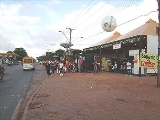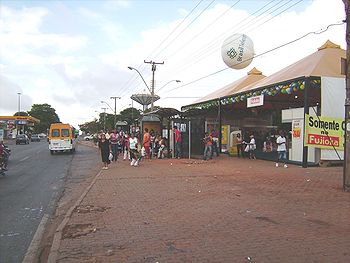
Ceilândia
Encyclopedia
Ceilândia is one of the most important satellite town
s near Brasília
, Brazil
. Currently, the city has a population of 350,000 inhabitants.
Located 24 kilometers from the Pilot Plan of Brasília, and linked by a four-lane highway, Ceilândia occupies an area of 232 square kilometers and is in one of the most privileged hydrographic areas of the Federal District. It has several streams forming its boundaries and is in the basin of the Descoberto River, which supplies 60% of the population of the Federal District.
Ceilândia was created by the government in the 1970s to keep people from moving into Brasília and setting up shanty town
s. The root of the name Ceilândia is 'CEI' ( (Squatters Eradication Center).
In 1969, after only nine years of existence, Brasília already had 79,128 people living in shacks (favela
s), out of a population of 500 thousand inhabitants in all the Federal District. In that year a seminar took place in Brasília concerning social problems of the Federal District. The shanty dwellers were the most serious problem. The Governor at that time, Hélio Prates da Silveira, decided to eradicate the shanty towns and a commission was formed.
Seventeen thousand six hundred and nineteen lots were laid out and in 1970 the first construction began. In nine months the transfer of the families was concluded with the streets opened In the beginning it was dramatic. The population had no water, no public lighting, no public transport and fought against the dust, the mud and the flash flood
s.
Today Ceilândia is the largest electoral college of the Federal District and the most populous city, with more inhabitants than the Pilot Plan. It occupies a total of 91 residential squares laid out like Brasília, intercalated by areas for local commerce, churches and schools. There are also some special areas that are set aside to provide community services.
 An active commercial center, it has 4,500 commercial establishments and 1,600 small industries. The economically active population is more than 160,000 people.
An active commercial center, it has 4,500 commercial establishments and 1,600 small industries. The economically active population is more than 160,000 people.
Two important locals of Ceilandia are The Water Tank, in Ceilândia Centro, and the - local where singers of northeast of Brazil presents shows (Oscar Niemeyer's work).
). About 70% of the population is of Northeastern origin. The presence of the Northeast culture can be seen in the number of open-air fairs (13 in all)
The fairs () are also an alternative for the workers that did not find space in the economy of the Federal District. In most of them, fruits, foods, clothes and footwear are commercialized. The Fair of the Producer sells wholesale and supplies almost 50% of the Federal District.
The Central Fair , is the largest of all. It occupies an area of seven thousand square meters and sells household articles, tools, electric appliances, fruits, vegetables, and poultry. It is located next to the (Water Tower) - the symbol of Ceilândia.
But the most peculiar fair, without doubt, is the , where one can find almost everything, new or used, entire or broken, and things there can be sold or exchanged.
Satellite town
A satellite town or satellite city is a concept in urban planning that refers essentially to smaller metropolitan areas which are located somewhat near to, but are mostly independent of, larger metropolitan areas.-Characteristics:...
s near Brasília
Brasília
Brasília is the capital city of Brazil. The name is commonly spelled Brasilia in English. The city and its District are located in the Central-West region of the country, along a plateau known as Planalto Central. It has a population of about 2,557,000 as of the 2008 IBGE estimate, making it the...
, Brazil
Brazil
Brazil , officially the Federative Republic of Brazil , is the largest country in South America. It is the world's fifth largest country, both by geographical area and by population with over 192 million people...
. Currently, the city has a population of 350,000 inhabitants.
Located 24 kilometers from the Pilot Plan of Brasília, and linked by a four-lane highway, Ceilândia occupies an area of 232 square kilometers and is in one of the most privileged hydrographic areas of the Federal District. It has several streams forming its boundaries and is in the basin of the Descoberto River, which supplies 60% of the population of the Federal District.
Ceilândia was created by the government in the 1970s to keep people from moving into Brasília and setting up shanty town
Shanty town
A shanty town is a slum settlement of impoverished people who live in improvised dwellings made from scrap materials: often plywood, corrugated metal and sheets of plastic...
s. The root of the name Ceilândia is 'CEI' ( (Squatters Eradication Center).
In 1969, after only nine years of existence, Brasília already had 79,128 people living in shacks (favela
Favela
A favela is the generally used term for a shanty town in Brazil. In the late 18th century, the first settlements were called bairros africanos . This was the place where former slaves with no land ownership and no options for work lived. Over the years, many freed black slaves moved in...
s), out of a population of 500 thousand inhabitants in all the Federal District. In that year a seminar took place in Brasília concerning social problems of the Federal District. The shanty dwellers were the most serious problem. The Governor at that time, Hélio Prates da Silveira, decided to eradicate the shanty towns and a commission was formed.
Seventeen thousand six hundred and nineteen lots were laid out and in 1970 the first construction began. In nine months the transfer of the families was concluded with the streets opened In the beginning it was dramatic. The population had no water, no public lighting, no public transport and fought against the dust, the mud and the flash flood
Flash flood
A flash flood is a rapid flooding of geomorphic low-lying areas—washes, rivers, dry lakes and basins. It may be caused by heavy rain associated with a storm, hurricane, or tropical storm or meltwater from ice or snow flowing over ice sheets or snowfields...
s.
Today Ceilândia is the largest electoral college of the Federal District and the most populous city, with more inhabitants than the Pilot Plan. It occupies a total of 91 residential squares laid out like Brasília, intercalated by areas for local commerce, churches and schools. There are also some special areas that are set aside to provide community services.

Two important locals of Ceilandia are The Water Tank, in Ceilândia Centro, and the - local where singers of northeast of Brazil presents shows (Oscar Niemeyer's work).
Ceilândia and its fairs
Ceilândia is considered the second largest "Northeastern city" outside the Brazilian Northeast Region (the first one is São PauloSão Paulo
São Paulo is the largest city in Brazil, the largest city in the southern hemisphere and South America, and the world's seventh largest city by population. The metropolis is anchor to the São Paulo metropolitan area, ranked as the second-most populous metropolitan area in the Americas and among...
). About 70% of the population is of Northeastern origin. The presence of the Northeast culture can be seen in the number of open-air fairs (13 in all)
The fairs () are also an alternative for the workers that did not find space in the economy of the Federal District. In most of them, fruits, foods, clothes and footwear are commercialized. The Fair of the Producer sells wholesale and supplies almost 50% of the Federal District.
The Central Fair , is the largest of all. It occupies an area of seven thousand square meters and sells household articles, tools, electric appliances, fruits, vegetables, and poultry. It is located next to the (Water Tower) - the symbol of Ceilândia.
But the most peculiar fair, without doubt, is the , where one can find almost everything, new or used, entire or broken, and things there can be sold or exchanged.

